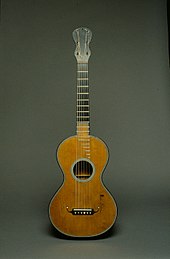 Early Romantic guitar (c. 1830, Paris) by Jean-Nicolas Grobert (1794–1869) | |
| String instrument | |
|---|---|
| Classification | String instrument (plucked) |
| Hornbostel–Sachs classification | 321.322 (Composite chordophone) |
| Inventor(s) | Ferdinando Gagliano (first known)[1] |
| Developed | 18th century [1] |
| Attack | Fast |
| Related instruments | |
| Builders | |
The early romantic guitar, the guitar of the Classical and Romantic period, shows remarkable consistency from 1790 to 1830.[1] Guitars had six or more single courses of strings while the Baroque guitar usually had five double courses (though the highest string might be single). The romantic guitar eventually led to Antonio de Torres Jurado's fan-braced Spanish guitars, the immediate precursors of the modern classical guitar.
From the late 18th century the guitar achieved considerable general popularity though, as Ruggero Chiesa stated, subsequent scholars have largely ignored its place in classical music.[2] It was the era of guitarist-composers such as Fernando Sor, Ferdinando Carulli, Mauro Giuliani and Matteo Carcassi. In addition several well-known composers not generally linked with the guitar played or wrote for it: Luigi Boccherini and Franz Schubert wrote for it in several pieces,[3] Hector Berlioz was a proficient guitarist who neither played keyboards nor received an academic education in music,[4] the violin virtuoso Niccolò Paganini played guitar informally and Anton Diabelli produced a quantity of guitar compositions (see List of compositions by Anton Diabelli).
- ^ a b c Stalking the Oldest Six String Guitar
- ^ Quoted at the "Early Romantic Guitar" website
- ^ See Ars Classical website
- ^ "EssentialsOfMusic.com". EssentialsOfMusic.com. Archived from the original on 11 April 2009. Retrieved 13 March 2010.